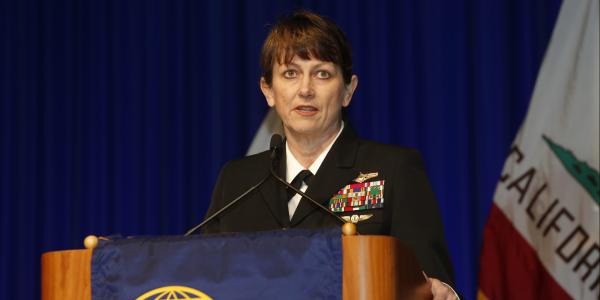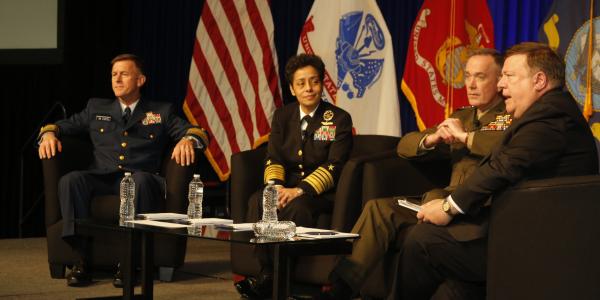Global Issues Shape Sea Services' Operations
West 2015
The SIGNAL Magazine Online Show Daily
Day 3
Quote of the Day:
“Do not relent ever when the Chinese want to put a finger in our chest. When they say our presence is just to contain China, they flatter themselves.”—Adm. Timothy J. Keating, USN (Ret.), former commander, U.S. Pacific Command
Peacekeeping and warfighting needs always have shaped military forces, but a more dynamic world is exerting more influence than ever on the U.S. sea services. In the past, they knew what to expect in terms of an enemy and a war. Now, the adversaries are more diverse, their tactics unpredictable and the warfighting domains more dynamic.
Dealing with these uncertainties dominated discussions on the third and final day of West 2015, held February 10-12 in San Diego. The U.S. Navy’s cyber leader joined service commanders and retired flag officers to present illuminating perspectives on these issues.
The tone of the day may have been struck by Adm. Michelle J. Howard, USN, vice chief of naval operations, during the day’s final event. She allowed that debate often centers around whether the Navy should have a force sized to win the most likely war or a force sized to meet day-to-day demands. The goal is to meet the first criteria, she stated.
And that war could come from a number of different scenarios. A panel on the Indo-Asia Pacific region examined many potential combinations of conflict as well as cooperation. Panel moderator David M. Finkelstein, vice president and director, China Studies, Center for Naval Analyses, noted that the administration listed contested maritime territorial claims—mostly involving China—and a provocative North Korea as the two big threats to peace in the Asia-Pacific region.
However, Adm. Timothy J. Keating, USN (Ret.), former commander, U.S. Pacific Command, disagreed. North Korea sits alone atop the list; the contested maritime claims “don’t cost me any sleep,” he said.
Vice Adm. Doug Crowder, USN (Ret.), former commander, Seventh Fleet, said the larger issue is China’s claims, its building structures on disputed lands and use of intimidation “to pursue incredible claims.” And Finkelstein noted that the People’s Liberation Army Navy (PLAN) now is viewed by China’s leadership as being on the point end of the spear for projecting Chinese power.
Rear Adm. Douglas McAneny, USN (Ret.), former commander, Submarine Force U.S. Pacific Fleet, said that there is no doubt that, given the trajectory it is on, there is going to be a much more muscular China in the region. However, Adm. McAneny offered that the most fascinating country is North Korea. He had hoped the new leadership would be more worldly and willing to reach out to others, but instead it has become more bizarre. He worries about a nuclear North Korea.
The dynamic in the Asia-Pacific region is changing as more countries become involved in the activities that define geopolitics in that vast area. One of these is India. Adm. Crowder said that the past five years have seen a slow progression of India coming out of its shell. He described it as “a budding change of significance in that area.” Finkelstein stated that India is rethinking its role in the region.
Adm. Timothy J. Keating, USN (Ret.), former commander, U.S. Pacific Command, said “fiercely nonaligned, India is coming around gradually to the clear realization that we are an essential partner.” Most other nations in the region view the United States as the bulwark of peace, security and prosperity. That burden is one the country should accept readily, panelists suggested, but the United States must not vacillate or it will lose vital support throughout the region.
Adm. Crowder was blunt about the role the United States must play if it is to be taken seriously in the Asia-Pacific region. If the United States is not transparent in dealing with China and does not stand up to it when necessary, then other nations will doubt U.S. resolve, he charged.
Adm. Keating was similarly blunt about dealing with China. “Do not relent ever when the Chinese want to put a finger in our chest,” he warned. “When they say our presence is just to contain China, they flatter themselves.”
Most of the U.S. Navy’s Asia-Pacific operations over the past few years have been in humanitarian assistance/disaster relief (HA/DR). That has had a major effect on building relationships and adding allies in the region. Adm. Crowder pointed out that the United States had the barest of relationships with Indonesian officials prior to the tsunami that killed nearly a quarter million people in December 2004. The U.S. tsunami response began a new relationship between the two nations, and it resulted in soaring U.S. popularity there.
Even China was affected by the HA/DR response to the tsunami. Embarrassed by criticism of its relatively small relief response, China now recognizes the importance it poses. Adm. Crowder said that in its new program objective memorandum, the first ship being built by its navy is a hospital ship.
The most local of the sea services is the U.S. Coast Guard, and it too is strongly influenced by international events. Adm. Paul F. Zukunft, USCG, commandant of the Coast Guard, related how Central America has become a hotbed of crime that is having a ripple effect in the Western Hemisphere. Poverty-stricken Honduras in particular is more violent than Iraq was at the worst of the insurrection, the admiral offered. As a result, organized crime has taken hold, and the Coast Guard is interdicting more and more cocaine than it used to. The Coast Guard has had to rebalance its forces to fill in some of the gaps in the Western Hemisphere, he said.
For the sea services, the most international influence of all is cyber, which knows no geopolitical borders. Vice Adm. Jan Tighe, USN, commander, Fleet Cyber Command and commander, 10th Fleet, pointed out that the Navy no longer can focus only on peer nation-state military competitors in cyberspace. Criminals, hackers and other cybermarauders must be taken into account. Even if the attack is not destructive, it could be detrimental to national interests.
“The Sony hack demonstrated that cyber attacks on noncritical infrastructure still can take aim at traditional American values,” she declared.
The Navy is leveraging all-source intelligence to identify emerging threats, the admiral said. Her command layers sensors, analysts and hunters inside the network. Automatic intelligence, surveillance and reconnaissance is used to trigger responses in the network, or the network is maneuvered out of harm’s way when a threat is seen coming.
Gen. Joseph F. Dunford Jr., USMC, commandant of the Marine Corps, described cyber as both a challenge and an opportunity. The Corps is looking at how a Marine Air-Ground Task Force can leverage offensive cybercapabilities.
The U.S. Coast Guard is the only one of the sea services in the Department of Homeland Security, and cyber plays a large role in its operations. Adm. Zukunft described how a cyber attack on a U.S. seaport could wreak havoc on the U.S. economy. The port of Los Angeles/Long Beach has a cargo throughput of $1 billion each day, and like most ports its activities are automated. U.S. ports have asked the Coast Guard for cyber protection, and the service plans to roll out a cyber strategy next month, Adm. Zukunft said.
Mark your calendars now for West 2016, to be held February 17-19 in San Diego!






Comments